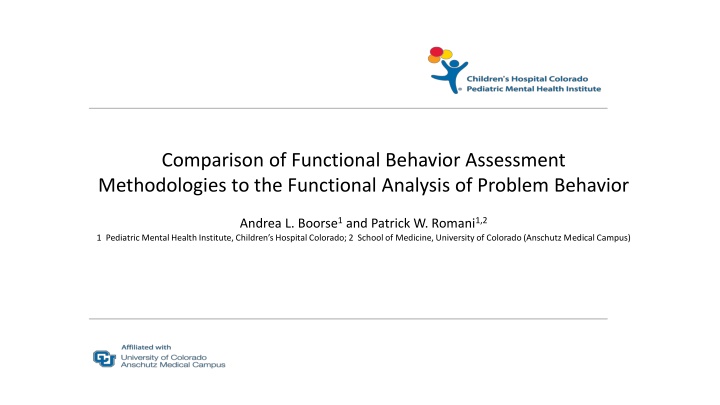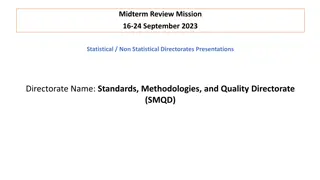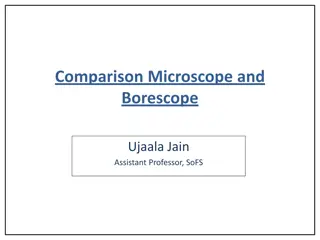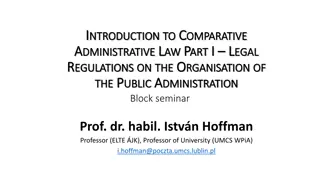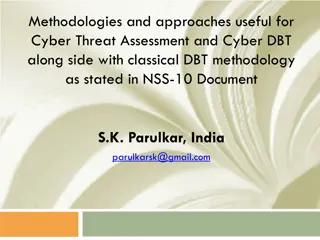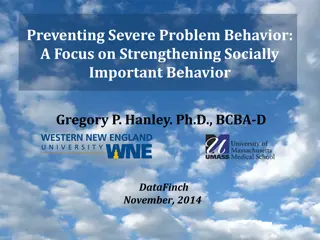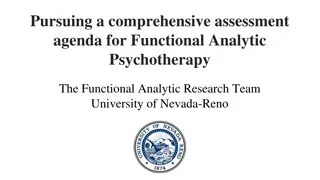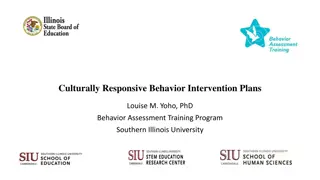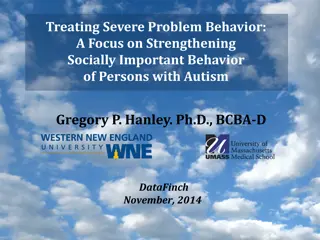Comparison of Functional Behavior Assessment Methodologies
This study compares various methodologies for conducting Functional Behavior Assessments (FBA), including indirect assessments, direct assessments, questionnaires like QABF and FAST, as well as Functional Analysis incorporating Antecedent-Behavior-Consequence (ABC) interviews and narratives. The ABC interview explores behaviors in different contexts like escape, tangible, and attention, providing examples of questions and responses. Interpretation of FBA results based on ABC interview findings is also discussed.
Download Presentation

Please find below an Image/Link to download the presentation.
The content on the website is provided AS IS for your information and personal use only. It may not be sold, licensed, or shared on other websites without obtaining consent from the author.If you encounter any issues during the download, it is possible that the publisher has removed the file from their server.
You are allowed to download the files provided on this website for personal or commercial use, subject to the condition that they are used lawfully. All files are the property of their respective owners.
The content on the website is provided AS IS for your information and personal use only. It may not be sold, licensed, or shared on other websites without obtaining consent from the author.
E N D
Presentation Transcript
Comparison of Functional Behavior Assessment Methodologies to the Functional Analysis of Problem Behavior Andrea L. Boorse1and Patrick W. Romani1,2 1 Pediatric Mental Health Institute, Children s Hospital Colorado; 2 School of Medicine, University of Colorado (Anschutz Medical Campus)
Functional behavior assessment Functional Behavior Assessment Indirect Assessment Direct Assessment Questionnaires (QABF and FAST) Functional Analysis ABC Interview ABC Narrative
Functional behavior assessment Functional Behavior Assessment Indirect Assessment Direct Assessment Questionnaires (QABF and FAST) Functional Analysis ABC Interview ABC Narrative
ABC Interview Antecedent-Behavior-Consequence (ABC) Interview (O Neill et al. 1997) Functional Context Example Questions Responses Escape How does your child behave when asked to take a shower? What about complete homework? Tangible How does your child act when told, No they cannot have a specific toy or snack? Attention How does your child act when you are on the phone or playing with their sibling?
ABC Interview Antecedent-Behavior-Consequence (ABC) Interview (O Neill et al. 1997) Functional Context Example Questions Responses Escape How does your child behave when asked to take a shower? What about complete homework? He ignores me and then may throw toys. He doesn t do homework. Tangible How does your child act when told, No they cannot have a specific toy or snack? He flips out. I get hit and bit until I finally let him keep playing the iPad. Attention How does your child act when you are on the phone or playing with their sibling? He usually plays alone well. Finds the iPad and that keeps him busy.
Interpretation FBA Method Results ABC Interview Escape and Tangible
Functional behavior assessment Functional Behavior Assessment Indirect Assessment Direct Assessment Questionnaires (QABF and FAST) Functional Analysis ABC Interview ABC Narrative
Interpretation FBA Method Results ABC Interview Escape and Tangible Questions About Behavioral Function Escape Functional Assessment Screening Tool Escape
Functional behavior assessment Functional Behavior Assessment Indirect Assessment Direct Assessment Questionnaires (QABF and FAST) Functional Analysis ABC Interview ABC Narrative
ABC Narrative 0.65=65% 0.35=35%
Interpretation FBA Method Results ABC Interview Escape and Tangible Questions About Behavioral Function Escape Functional Assessment Screening Tool Escape ABC Narrative Escape and Attention
Functional behavior assessment Functional Behavior Assessment Indirect Assessment Direct Assessment Questionnaires (QABF and FAST) Functional Analysis ABC Interview ABC Narrative
Functional analysis of problem behavior (Iwata et al., 1982/1994)
Interpretation FBA Method Results ABC Interview Escape and Tangible Questions About Behavioral Function Escape Functional Assessment Screening Tool Escape ABC Narrative Escape and Attention Functional Analysis of Problem Behavior Escape
Purpose: Study 1 What combination of FBA methods relates best to the FA? Do FBA methods discriminate certain functions better than others?
Dependent variables Agreement was defined as when the results of one or more assessments matched the function(s) of problem behavior identified in the FA. Disagreement was defined as when the results of one or more assessments did not match the function(s) of problem behavior identified in the FA.
Interpretation FBA Method Results Percentage Correspondence ABC Interview Escape and Tangible 50% Questions About Behavioral Function Escape 100% Functional Assessment Screening Tool Escape 100% ABC Narrative Escape and Attention 50% Functional Analysis of Problem Behavior Escape ----
Discussion: Study 1 With previous research showing use of direct FBA methods relates best to the FA (Alter et al., 2008), and this sample showing equal correspondence with the combination of indirect methods, the combination of the indirect and direct methods may be most useful for practitioners.
Discussion Study 1 BCBAs are not routinely using functional analysis with 48.3% of BCaBAs stating they Almost Never use functional analysis in their practice. (Oliver et al., 2015) BCaBA BCBA BCBA-D 50.0% 25.0% 0.0% Never Almost Never Almost Always Always Not Applicable
Purpose: Study 2 What combination of FBA methods relates best to the FA? Do FBA methods discriminate certain functions better than others?
Signal Detection Theory Variables were defined as follows: o A hit was defined as an FBA method identifying the same function(s) as the FA. o A correct rejection occurred when an FBA method omitted a function that was not identified by FA. o A miss was when an FBA method did not identify a function that was identified by FA. o A false alarm was when an the FBA method identified a function that was not identified by FA.
Discussion: Study 2 Follow-up analysis of these data using signal detection theory showed escape as the reinforcer most likely to be identified via both indirect and direct FBA methods. Tangible and attention functions were most likely to be correctly rejected. Approximately equal levels of misses and false alarms occurred across behavioral functions.
General Discussion In conclusion, these data showed that, within this sample of 14 children, the first and second best FBA combination was: ABC Interview + QABF + FAST= 55.93% correspondence to the FA ABC Interview + QABF + ABC Narrative= 55.86% correspondence to the FA The escape function was most accurately identified throughout all FBA assessments.
Future Research and Limitations Using these data, a logical second experiment would be to evaluate if treatment matched to the results of the most- and least-accurate FBA methods produces different treatment outcomes. Future researchers should replicate these data across different levels of care (e.g., intensive outpatient, outpatient, school-based).
Acknowledgements Program Sponsors for their generosity in allocating funds for this program Dr. Dominique Martinez (CCTSI Office of Diversity and Inclusion). Dr. Douglas Novins and Dr. Jennifer Hagman (PMHI). 2017 Summer Research Program for Undergraduate Students Dr. Merlin Ariefdjohan who ran this program and provided unending support and assistance. Marisa Deguzman for helping me with my poster presentation and providing support to the entire cohort. Emmaly Owens & Robert Evans for their support and help running this program Mentor Extra-ordinaire! Dr. Patrick Romani for mentoring me this summer and being my #1 support throughout this program.
